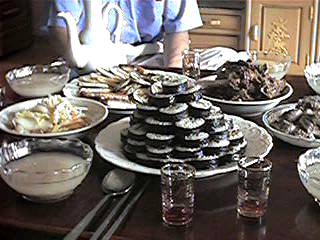Chusok is the biggest holiday of the year in Korea. It is a time for honouring ancestors. All Koreans return to their parents' home or to the home of their eldest brother. Sean, a teaching colleague, and his girlfriend Kyoung Hee, invited Jeff and I to visit Kyoung Hee's home with them.
Sean (left),
Kyoung Hee (middle) and yours truly (right) set out, bags in hand, down
the streets of Pansong-Dong. Jeff, the unseen photographer, began his work a la
digital camera which allows him to download directly from the film to the internet.
Go ... Super Jeff!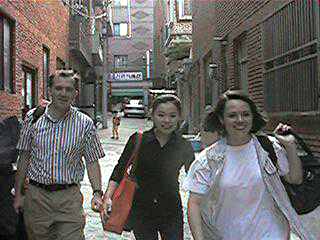
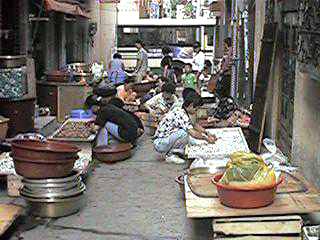
Much was astir at the end of our alley/street. Where on an average day, children could be found playing in this space, today, important work was being done. Chusok preparations had begun the night before and continued at 9am, when we walked through the production lines. The local "bakery" had exploded beyond its walls into the street; a hive of activity, and a representative sample of the work ethic of Koreans. They are indeed a hard-wroking people. The women literally work from morning to night, cleaning, cooking, caring for children, selling, carrying, ... you name it - they do it.
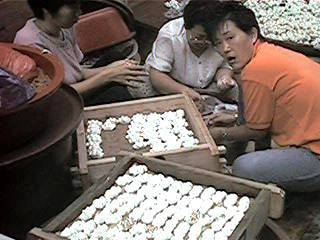
Songpyon, the most famous traditional Chusok desert made of a rice dough and stuffed with a sort of Graham Cracker crumb filling or red bean paste, is being made here by expert hands that knead and mould them into various shapes.
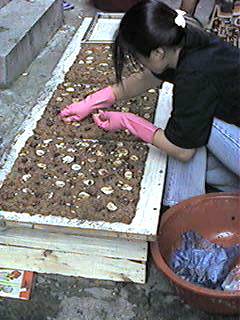 Another
variety of songpyon was being created. It bears a strong resemblance to
the Christmas fruit cakes in Canada but has one major difference. All the songpyon
fruit cakes get eaten. Rumour has it that not a single one is ever used as a doorstop,
bookend or "joke gift".
Another
variety of songpyon was being created. It bears a strong resemblance to
the Christmas fruit cakes in Canada but has one major difference. All the songpyon
fruit cakes get eaten. Rumour has it that not a single one is ever used as a doorstop,
bookend or "joke gift".
We hailed a cab from Pansong-Dong (i.e., Nowheresville in Pusan), to the train station. The driver was fairly tame by local standards, only veering into oncoming traffic two or three times, slowing down for most red lights and maintaining a moderate speed of approximately 80kmph on the city streets. He had a blast with his horn, honking every 6 seconds at anything within his peripheral vision. Traffic was not as heavy as expected so we didn't even get in an accident and arrived at the train station in plenty of time.
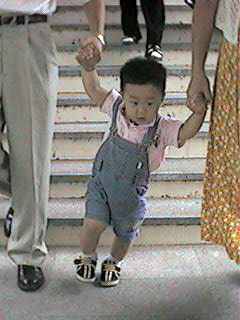
 Young
and old were mobile, making their way to their respective families' homes for
the holiday. Family: the theme of Chusok, and the theme of many Korean traditions.
Family is probably the most important thing to Korean people, and being "Korean"
possibly runs a close second.
Young
and old were mobile, making their way to their respective families' homes for
the holiday. Family: the theme of Chusok, and the theme of many Korean traditions.
Family is probably the most important thing to Korean people, and being "Korean"
possibly runs a close second.
A nice lady directed us toward the correct train. She took a shine to Jeff and appeared flattered (and flattened) when he took her photo.
70% of South Korean land is mountainous. They are gentler and less dramatic than mountains found in North America.
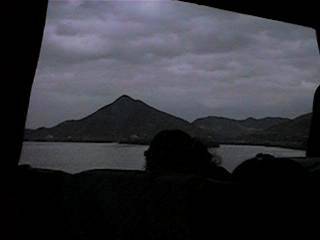
The Korean children are adorable.
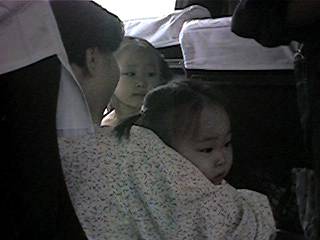
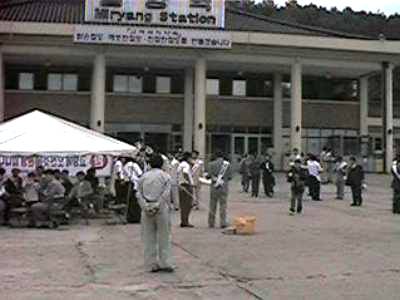 Upon
arrival at Miryang, we were greeted by some gentlemen who welcomed us with a cup
of prune juice. Uhhh ... thanks.
Upon
arrival at Miryang, we were greeted by some gentlemen who welcomed us with a cup
of prune juice. Uhhh ... thanks.
From Miryang we took
a cab to Kyoung Hee's village. Now this was a real cab ride. We were
holding on for dear life as the driver swerved and braked, making his was maniacally
through the mountains. Did he think we were late for something more important
than life itself? Did he want to "give these foreigners the ride
of their life" (and death)? Were the brakes malfunctioning? No,
of course not. He was just an average Korean cab driver. We all knew that when
he passed a car on a narrow bridge with a truck coming straight for us. 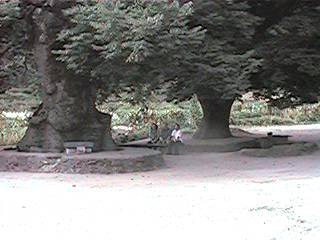
The village. First of all, we met the 500-year-old grandmother and grandfather trees that were the entrance to the village and protectors of all therein.
Sean
and Kyoung Hee began down their first walk together down this road. 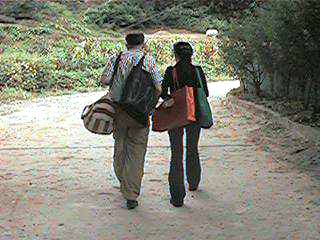
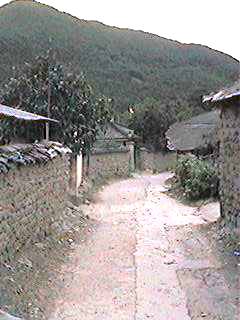
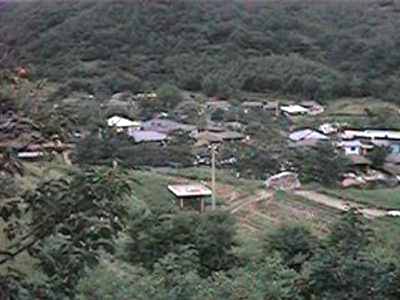
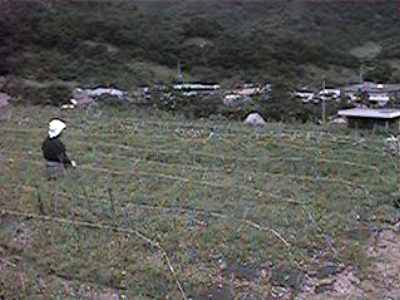
Here
is Kyoung Hee's village.
For some of the villagers,
we represented their first encounter with foreigners.
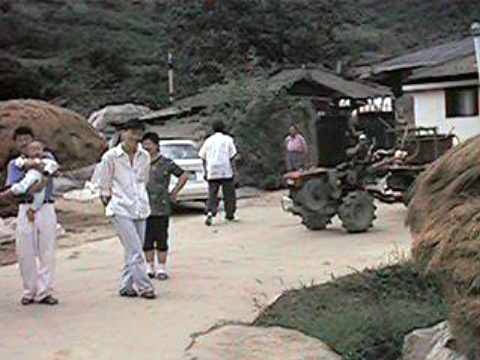
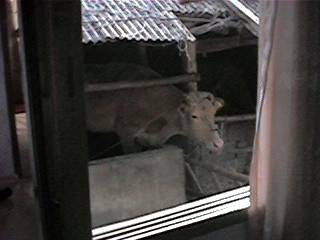 We
had a look around Kyoung-Hee's family homestead. In the yard were outhouses and
just a few feet from the house was a barn with some nice cows.
We
had a look around Kyoung-Hee's family homestead. In the yard were outhouses and
just a few feet from the house was a barn with some nice cows.
Inside were modern conveniences such as a coloured television and cellular phone. Again, this intersection of old and new struck a chord of irony.
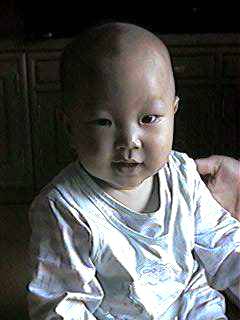 Kyoung
Hee's family were very kind, generous and welcoming. Her mom, dad, oldest brother,
sister-in-law and their "star", the first grandchild were all at home.
There was a strength of character about all these people that is hard to explain.
Even "SuperBaby, that gorgeous, little child, seemed to possess "it".
Kyoung
Hee's family were very kind, generous and welcoming. Her mom, dad, oldest brother,
sister-in-law and their "star", the first grandchild were all at home.
There was a strength of character about all these people that is hard to explain.
Even "SuperBaby, that gorgeous, little child, seemed to possess "it".
We were presented with an incredible spread of Korean food prepared by Kyoung Hee's mother and sister-in-law. It was an afternoon "snack": ha!
At the very bottom you see the metal chopsticks and spoon that are standard Korean silverware. They require even more skill than the wooden chopsticks since the food slips off them easier. Korean silverware: not for the weak of digits or the "just bloody starving so give me a fork and knife right now before my empty stomach rejects me and implodes!!" type of eater. In the centre is a tower of kim-bop, which is rice, vegetables, crab, etc., rolled in seaweed, sliced and served as you see here. The soup to the left is a cold, sweet rice soup. The dish just behind the soup is a kim'chi, made of pickled cabbage, carrots and other vegetables. To the right of that is breaded zucchini and a combination of fried foods such as beef, crab, sweet potato, called tweegeem. To the right is a platter of beef ribs (kalbi) in a sort of honey garlic sauce. Bowls of rice are not visible but are served with every meal.
After lunch Kyoung Hee's brother, Hee Gon, drove us cross-country to visit a temple. En route, we saw grassy mounds behind farmhouses where ancestors were buried. Many of the graves had been tended as is Chusok tradition. On Tuesday morning, ceremonies would be held to honour the memory of these ancestors. Koreans believe their ancestors do not go to another world; there is no"next world." When a person dies he or she lives on through his or her sons. This is part of the reason there is pressure for Korean women to produce male offspring.
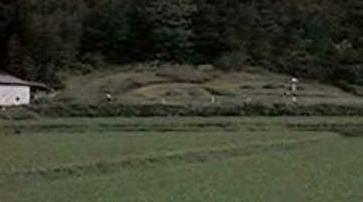 The
religious ceremony, attended only by men, is held every Chusok. It is very important
in Korean culture because it is considered a connection between the living and
dead. Food and drink is taken to the grave. Rice cakes, apples, pears, and soju
are placed at the gravesite so the ancestors and the living can eat and have a
drink together. Koreans talk to their ancestors at this time. It is believed that
ancestors give fortune to and protect their offspring.
The
religious ceremony, attended only by men, is held every Chusok. It is very important
in Korean culture because it is considered a connection between the living and
dead. Food and drink is taken to the grave. Rice cakes, apples, pears, and soju
are placed at the gravesite so the ancestors and the living can eat and have a
drink together. Koreans talk to their ancestors at this time. It is believed that
ancestors give fortune to and protect their offspring.
Soon we arrived at P'yoch'ungsa ("sa" at the end of a word means "temple" so in English, this is P'yoch'ung Temple).
Temples are found all over Korea and consist of a number of buildings as well as the area surrounding them. Temples are generally set in the mountains. One thousand years ago, this was not the case. Temples were often established in cities. Later, during the Chosun Dynasty (1392-1910), the administration expelled Buddhism and accepted Confuscianism as the official religion/philosophy of Korea. It is said that the king and people still worshipped Buddha in private but in public, Confucianism prevailed. Consequently, Buddhists hid their temples away in the mountains where they could worship in peace.
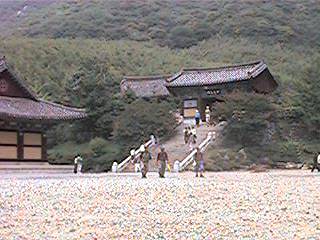 This
is the entrance to P'yoch'ungsa. It is believed that people are exiting one world
and entering another as they pass through the gates. Left behind are monetary
and material concerns of the modern-day world; what lays beyond is a peaceful,
"heavenly" world. As people walk through the gate, their minds are calmed
so that they can move toward a peaceful state of mind.
This
is the entrance to P'yoch'ungsa. It is believed that people are exiting one world
and entering another as they pass through the gates. Left behind are monetary
and material concerns of the modern-day world; what lays beyond is a peaceful,
"heavenly" world. As people walk through the gate, their minds are calmed
so that they can move toward a peaceful state of mind.
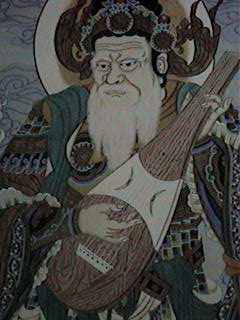
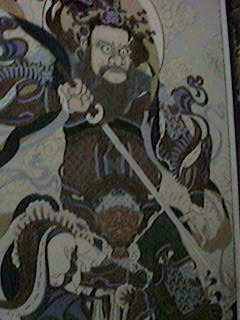 Here
are two of the four guards who aid in this transfer from one world to another.
Althought they appear passive, seated on the walls of the entrance, they are in
fact, very active spiritually. For they have been entrusted with the task of keeping
the temple precinct sacred and free of evil influence. They do this in many ways.
They ward off evil spirits. Also, as people pass through their gates, the guards
assist in cleansing their minds of greed, anger and other unwelcome "worldly" thoughts;
smoothing the transition to calmness of spirit. Finally, the guards offer friendship
and welcome to well-meaning visitors.
Here
are two of the four guards who aid in this transfer from one world to another.
Althought they appear passive, seated on the walls of the entrance, they are in
fact, very active spiritually. For they have been entrusted with the task of keeping
the temple precinct sacred and free of evil influence. They do this in many ways.
They ward off evil spirits. Also, as people pass through their gates, the guards
assist in cleansing their minds of greed, anger and other unwelcome "worldly" thoughts;
smoothing the transition to calmness of spirit. Finally, the guards offer friendship
and welcome to well-meaning visitors.
Although these guards might appear intimidating to unsuspecting visitors, Kyoung Hee explained that they are, in fact, comical and intended to be cartoon-like; not threatening. In Korean folk tradition and literature, these guards are satirical in appearance and function.

It is believed that energy, both physical and spiritual, comes from the mountains. Temple buildings allow fresh air to pass through so the energy is always present within. This represents a communion of man's energy and the mountain's energy. This positive energy is important for disciplining the mind and helps worshipping visitors find inner calm and peace.
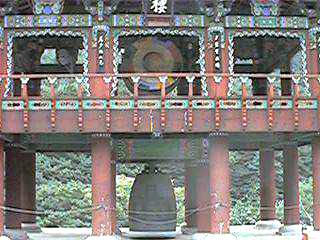
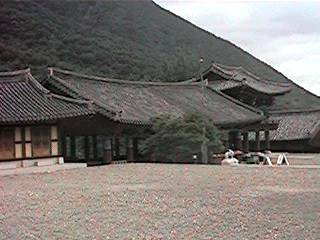
Some Korean people were praying in the buildings. Of course, worship takes various forms but some common themes involve requests for comfort of mind, modesty, and a healthy family.
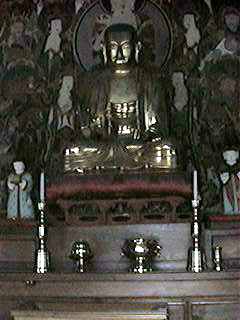 The
worshipping ritual begins in a standing position. Hands are joined in front of
the chest and the head is bowed. Then the hands separate and worshipper bows by
kneeling on the floor. The hands are placed on the floor next to the forehead,
which rests on the floor. It is believed that arrogance comes from the head so
this action invites modesty. After speaking to Buddha in this humble position,
the worshipper stands up slowly and begins again.
The
worshipping ritual begins in a standing position. Hands are joined in front of
the chest and the head is bowed. Then the hands separate and worshipper bows by
kneeling on the floor. The hands are placed on the floor next to the forehead,
which rests on the floor. It is believed that arrogance comes from the head so
this action invites modesty. After speaking to Buddha in this humble position,
the worshipper stands up slowly and begins again.
The physical actions are an essential part of prayer because Koreans believe that a healthy body and healthy mind come hand in hand. It is believed that one bow washes away one sin. In Buddhism, man has 108 agonies so usually people bow 108 times when they worship.
But on this day, we weren't agonizing over anything; we were just tourists checking the place out.
.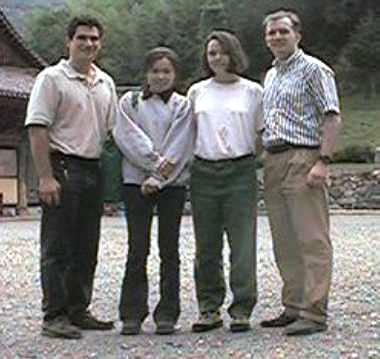
Jeff,
Kyoung Hee, Sheila and Sean
It was ironic that adjacent
to the traditional was blatant evidence of the modern world in the form of a satellite
dish. The juxtaposition of cultural preservation with modern technology was unexpected
and amusing.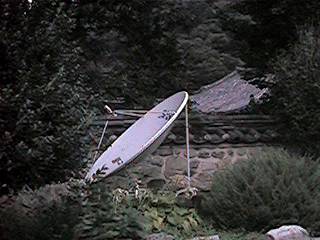 A souvenir shop at the temple was yet another reminder of the coexistence of tradition
and modernization.
A souvenir shop at the temple was yet another reminder of the coexistence of tradition
and modernization.
After looking around, we walked to a tea house further up the mountain.
We
met a baby bulldog on the way up. 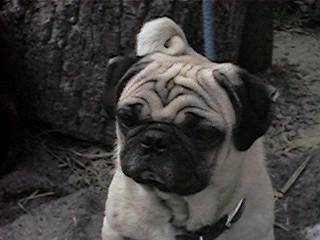
And
there stood the tea house ...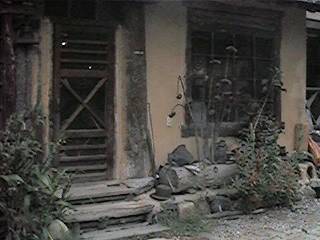 made
of wood and clay, its beauty natural and understated. It seemed like this place
had been around since tea was first discovered.
made
of wood and clay, its beauty natural and understated. It seemed like this place
had been around since tea was first discovered.
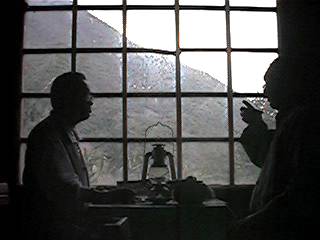 Inside,
two older Korean men sat next to one window, discussing issues of the day. Their
silhouettes moved about the background of beautiful hills.
Inside,
two older Korean men sat next to one window, discussing issues of the day. Their
silhouettes moved about the background of beautiful hills.
People talked in low voices ... a calmness prevailed. It would be an understatement to say this place had atmosphere.The hot pine-flavoured tea was sweet, warming us into an even more relaxed state. After an couple of hours or so (who knew or really cared exactly how long? time was irrelevant there), we descended the hill and made our way back to the village.
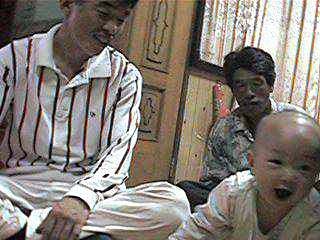 We
were greeted by Kyung Hee's younger brother, Sung Gee, who was home from college
for the weekend. We sat on the living room floor, played with Super Baby and communicated
as much as body language and "Konglish" would allow. In the living room,
we sat on the floor. There is no western-style furniture like chairs and sofas;
social interaction takes place at ground level. Heat comes from the floor so it's
quite comfortable.
We
were greeted by Kyung Hee's younger brother, Sung Gee, who was home from college
for the weekend. We sat on the living room floor, played with Super Baby and communicated
as much as body language and "Konglish" would allow. In the living room,
we sat on the floor. There is no western-style furniture like chairs and sofas;
social interaction takes place at ground level. Heat comes from the floor so it's
quite comfortable.  We
saw Super Baby's "blue spot" which all Korean babies are born with.
It's a fair-sized blue spot that looks like a bruise on the baby's little butt
and that fades within the child's first two years of life.
We
saw Super Baby's "blue spot" which all Korean babies are born with.
It's a fair-sized blue spot that looks like a bruise on the baby's little butt
and that fades within the child's first two years of life.
Another feast soon arrived: an incredible Korean dinner. Woah!
After dinner we had opportunity to engage in the making of songpyon, another famous Chusok culinary tradition . Kyung Hee's mother & sister-in-law showed us how to knead the rice dough, form it into a circle, put the crumbs in & then mould it into a half-moon shape.
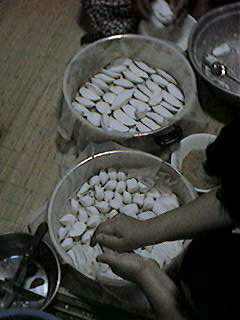
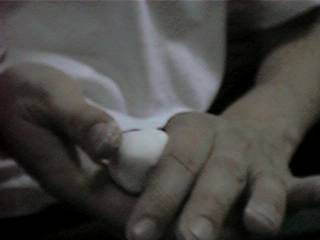
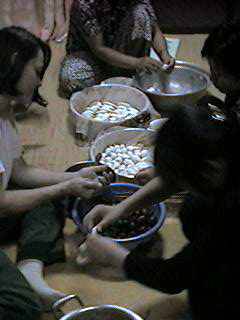
They
showed us many times. And we were quite impressed each time. We were even more
impressed as we unsuccessfully for the most part, attempted to emulate them. They
were surprised to see Sean and Jeff making songpyon. In Korea, men do not make
songpyon; nor do they serve, prepare or clean up after meals. This is women's
work. But Kyung Hee's brother, Hee Gon soon broke with tradition and gave it a
try for the first time in his life. 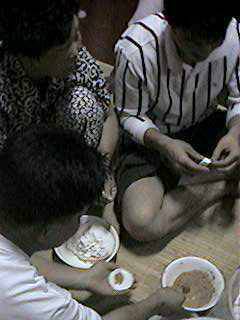
It had been a long day so we went to bed fairly early.
The next morning, breakfast (not unlike dinner in content and elaborateness) was served. Afterward, we went for a walk through the village. A friend of Kyoung-Hee, Chuck (his English nickname), came by on a tractor with his father and two brothers. They were on their way to work in the fields but Chuck hopped off to talk. He was not particularly concerned with work. So we walked around and he told us a bit about the local agricultural scene. Chuck said that 10 years ago, there was only one tractor for the whole village but now there was generally one per family. Like farmers anywhere in the world, they have to work hard and steadily to produce a successful crop. Crops grown included rice, vegetables and fruit. The rice was hard and green. It would be ripe in mid-October.
We came upon a big mound of dark stuff. I asked what it was and Chuck said, "Dtat, ... dtat i's shit!" It was the first time I'd ever heard a Korean say "shit." Ahhhh ... funny stuff.
Kyoung Hee took us up the mountain where her father owns land.
.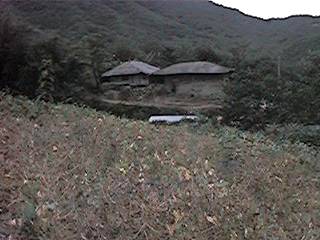
We saw apple trees. The Miryang Ice Valley is famous in for producing crunchy, sweet, delicious apples.
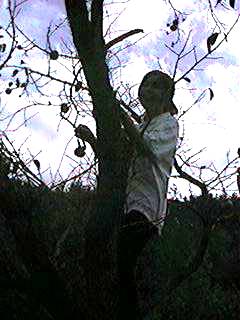 Kyoung
Hee picked parsimmins from the trees. They were soft, fresh, and melted
in your mouth; another gift from nature.
Kyoung
Hee picked parsimmins from the trees. They were soft, fresh, and melted
in your mouth; another gift from nature.
 Beautiful
flowers such as this one were also found in the orchard.
Beautiful
flowers such as this one were also found in the orchard.
Soon it was time to go. We wanted a photo of this wonderful family. It would be the first full family photo since the addition of Super Baby.
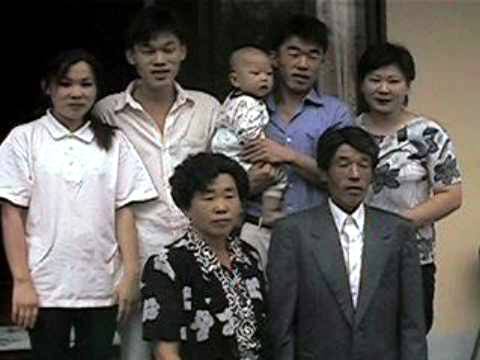
We said goodbye to the Kim's and made our way back to Pusan, tired and excited about our first Chusok experience. I hope they understood how grateful we were for having had the opportunity to share Chusok with them.
